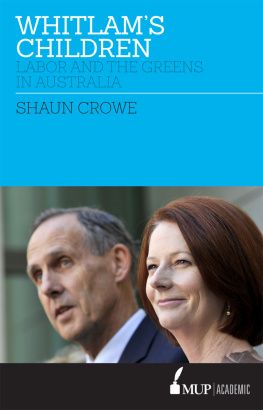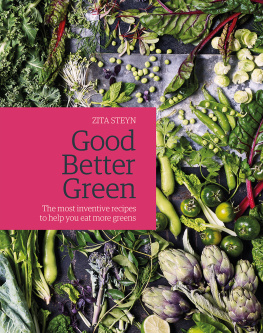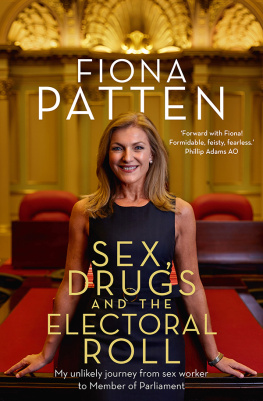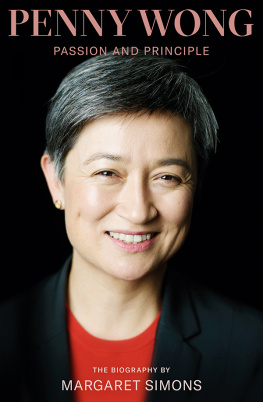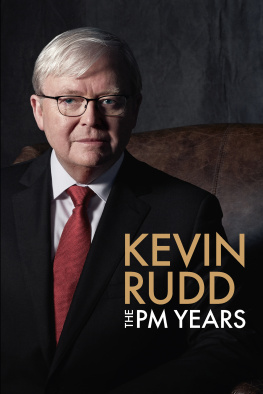The Australian Greens
The Australian Greens
From Activism to Australias Third Party
Stewart Jackson

MELBOURNE UNIVERSITY PUBLISHING
An imprint of Melbourne University Publishing Limited
1115 Argyle Place South, Carlton, Victoria 3053, Australia
mup-info@unimelb.edu.au
www.mup.com.au
First published 2016
Text Stewart Jackson, 2016
Design and typography Melbourne University Publishing Limited, 2016
This book is copyright. Apart from any use permitted under the Copyright Act 1968 and subsequent amendments, no part may be reproduced, stored in a retrieval system or transmitted by any means or process whatsoever without the prior written permission of the publishers.
Every attempt has been made to locate the copyright holders for material quoted in this book. Any person or organisation that may have been overlooked or misattributed may contact the publisher.
Text design by Phil Campbell
Cover design by Phil Campbell
Typeset by J&M Typesetting
Printed in Australia by OPUS Group
National Library of Australia Cataloguing-in-Publication entry
Creator: Jackson, Stewart, author.
Title: The Australian Greens : from activism to Australias third party / Stewart Jackson.
ISBN: 9780522869521 (hardback)
ISBN: 9780522867930 (paperback)
ISBN: 9780522867947 (ebook)
Notes: Includes bibliographical references and index.
Subjects: Australian GreensHistory.
Australian GreensPlatforms.
Green movementAustralia.
Balance of power.
PoliticiansAustralia.
Political partiesAustralia.
AustraliaPolitics and government21st century.
324.2940987
Contents
Acknowledgements
When I first wanted to start studying the Greens, it was in the context of being a political operative myselfa former state and national office holder, and staffer to the party and MPs. As a larger (or rather, smaller) cog in the party machine, I knew why I was there, but was never really clear why anybody else was. So I decided that I needed to learn about what made the organisationone that had been a part of my life for almost twenty yearsand its members tick. Eight years and a PhD later, this book is the end result, one that will hopefully provide a modicum of clarity as to why people engage in Australian politics on the Green side.
Along the way a few people have been rather helpful. Ariadne Vromen at Sydney University has been, at different times, a superlative supervisor, mentor and friend. Anika Gauja and Narelle Miragliotta have been outstanding collaborators and co-authors. My friend and office co-habitant Peter Chen inspires and assists at every turn, as a co-author, co-researcher and co-host. On the Green side, there are almost too many to name: Ben Spies-Butcher, Christine Cunningham and Penny Allman-Payne as co-convenors, Brett Constable in the National Office, all the people in the state offices across the country (especially Rowena Skinner and Margo Beilby in WA), and everyone who took the time to offer their thoughts, opinions and concerns. Then there are the political friends and confidantsLesa de Leau, Karl Haynes and Colombina Schaeffer are just three amongst the very manythank you for your time and patience.
Lastly, but definitely not least-ly, there is Judy Greenwood, without who this journey would probably not have taken place, and certainly without who it would not have been completed.
Glossary
| AEU | Australian Education Union |
| AMWU | Australian Manufacturing Workers Union |
| ANMF | Australian Nurses and Midwifery Federation |
| APEC | Asia-Pacific Economic Cooperation |
| APESMA | Association of Professional Engineers, Scientists and Managers Australia |
| ASMOF | Australian Salaried Medical Officers Federation |
| ASU | Australian Services Union |
| AWU | Australian Workers Union |
| CEPU | Communication, Electrical and Plumbing Union of Australia |
| CFMEU | Construction, Forestry, Mining and Energy Union |
| CPSU | Community and Public Sector Union |
| CSA | Civil Service Association |
| ETU | Electrical Trades Union |
| HACSU | Health and Community Services Union |
| HSOA | Hospital Salaried Officers Association |
| HSU | Health Services Union |
| IEU | Independent Education Union |
| LHMU | Liquor Hospitality and Miscellaneous Union |
| MEAA | Media Entertainment and Arts Alliance |
| NSM | New Social Movement |
| NSWTF | New South Wales Teachers Federation |
| NTEU | National Tertiary Education Union |
| NUW | National Union of Workers |
| PANSW | Police Association of New South Wales |
| PSA | Public Service Association |
| QPSU | Queensland Public Sector Union |
| QTU | Queensland Teachers Union |
| RTBU | Rail Tram and Bus Union |
| SDA | Shop, Distributive and Allied Employees Union |
| SSTUWA | State School Teachers Union of WA |
| TWU | Transport Workers Union |
| USU | United Services Union |
| UV | United Voice |
Introduction
Provoked by a desire to stop the environmental threat from the damming of the Huon and Serpentine Rivers and flooding of Lake Pedder in south-west Tasmania for a hydroelectricity scheme, in 1972 an array of activists banded together to form the United Tasmania Group, the precursor to the Tasmanian Greens, and one of the first green political parties globally. Thus the Australian Greens were born, and subsequently broadened into a loose collection of localised activist groups, which by 2015 had transformed dramatically into a powerful political party with thirty-four Members of Parliament (MPs) Australia-wide and operating as the third force in Australian party politics.
Since its inception, the Australian Greens have grown and changed, from a purely volunteer organisation operating from the backrooms of members houses to a party with offices in every state. How these changes have occurred and to what extent the earliest ideals of the first green groups have remained intact are questions I explore in this book. Like its German counterpart, the Australian Greens seem poised to make substantial electoral breakthroughs in the coming years. With this in mind, my aim in writing this book has been to pause and take stock of the Australian Greens history and see whether by looking into the past, applying key questions to its membersboth activists and staffers alikeand gathering some pertinent facts about the partys internal workings, I could unlock the answer to the question: how far have the Australian Greens moved from being a movement-based party to being a pragmatic professional one?
Why the Greens? Why now?
The Greens, as a political force in Australian politics, have been growing in influence since the 2004 federal election. The election of Adam Bandt to the seat of Melbourne in the 2010 Australian federal election, and his involvement in enabling the Gillard government to remain in office, gave the Greens leverage over the Australian Labor Party (ALP) at a national level. The election of Jamie Parker at the 2011 New South Wales election in the seat of Balmain gave the Greens a foothold in another lower house, to be followed by two more seats at the 2014 Victorian election and two in New South Wales at its 2015 state election. When the four new Greens Senators took their seats in the Australian Senate in July 2011, the Greens then held the balance of power in both houses of the federal parliament, which propelled the party to the forefront of media attention.
Next page


